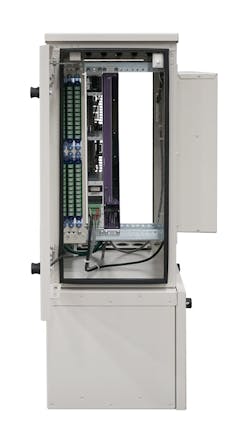ISE: What are two big challenges Clearfield faces in terms of network evolution/transformation?
Hill: I’ve always tried to keep the passive network architecture as simple as possible. It’s just plumbing. Big pipes split and feed smaller pipes until we get the water out of the faucet. The rate of water delivery varies depending on the quality of the network. Leaks occur or break and having a network that allows you to fix those breaks and leaks is critical. Simple. With fiber networks, the technology changes but the media remains the same. Evolving networks are simply network changes as a function of time. Adding network elements (splitters, wave-division muxes, additional fiber runs) are examples of those changes along with the technologies that run over them. Keeping up with those changes and those that come full circle is best served with a modular approach to the network that allows critical network consolidation/distribution points of fiber to be hot swapped as those fiber plumbing architectures evolve into the next best thing. This supports the network transformation we are seeing with network service providers becoming digital service providers by changing their networks into more virtualized, cloud-based architectures. This cloud transformation requires that the “plumbing” changes somewhat to push what makes sense for reduced latency and processing efficiencies to different areas of the broadband delivery system like the network edge. Clearfield’s FiberFlex product line allows broadband service providers to embrace network transformation while leveraging the investments they have made in our passive products and position them for the next evolution in network architectures.
ISE: What are the best ways to get fiber deployed quickly to the underserved and unserved while reducing costs at the same time?
Hill: Network performance, maintenance, and upgradeability must be considered when choosing a deployment strategy. A fiber network build that concentrates splicing in the fewest areas of the network as possible and leverages plug-and-play products where possible promotes a deployment model that utilizes skilled laborers in network environment locations that optimize their time and gains efficiencies. Lower skilled laborers perform the plug-and-play activities of the network with minimal but necessary training. Several network architectures support this model with varying degrees of costs in CAPEX and OPEX. Clearfield Application Engineers are experienced professional resources that are available to help a provider understand the pros and cons of each type of network architecture—helping them to determine the cost/benefit against their short- and long-term goals.
ISE: What is the telecom industry missing in terms of recruiting/retaining younger professionals? What is Clearfield doing in this area?
Hill: It’s safe to say that broadband services are a necessary utility in today’s world. Outside of a certification program that the FOA provides, there really is no apprenticeship program that every other utility trade has. In the past, this type of training, experience, and earned certifications were provided by the telco companies who used the BellCore standards to qualify and certify their technicians. In large part, these training organizations have been eliminated and the demand for training now falls on the manufacturers to provide. Clearfield recognized this long ago and invested significant resources in people, training programs, and additional tools like our BILT app that are designed to align with today’s modern technology learners to provide multiple avenues of product and industry certifications that will be seen as a real credible asset for broadband providers.
For more information, visit www.SeeClearfield.com.









